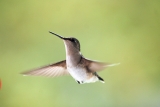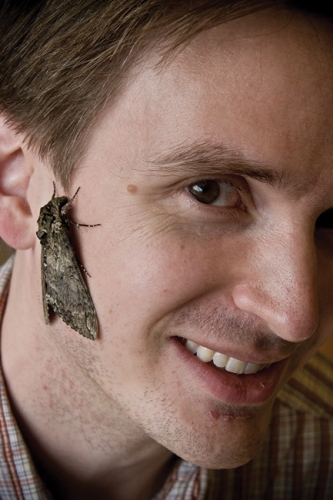A hummingbird turns and zips away in an instant when startled. A bat dives at its prey. A tiny fly zigzags through the air so quickly that a human can’t catch it.
Birds and bugs make these maneuvers seem effortless, but flying with that degree of precision is harder than it looks. “A moth doesn’t have a tail to use as a rudder,” Ty Hedrick says. “But we can’t design a little airplane, even with a rudder, that has the stability and maneuverability of an insect.” For the past year, Hedrick and his lab have been working on understanding just one type of maneuver: how animals use their wings to turn around when they’re upright in the air.
Sounds simple enough — but it’s taken a lot of physics just to get flight research off the ground.
In Hedrick’s lab, a hawkmoth hovers in front of a vial of sugar water, its wings beating rapidly like a hummingbird’s. A little more than a decade ago, Hedrick explains, scientists had only a general understanding of the physics behind how moths and many other creatures stay aloft.
As an undergraduate biology student, Hedrick worked with birds, raising (read: getting bitten by) Canada Geese and training starlings to fly in experiments. He didn’t get hooked on animal-flight research then; after graduation, he went to work as a software engineer for two years. He didn’t know that in the late 1990s, while he was taking his break from birds, scientists were making key discoveries in the field he’d be coming back to soon.
At that time, when scientists wanted to study animal flight they’d usually use a wind tunnel: a space where they can learn about flight mechanics under controlled wind conditions. In a wind tunnel, sensors attached to a stationary wing — of a bird or an airplane, for example — measure how much the wind pushes on the wing and how much the wing pushes back.
Some animals, including most birds, pass the wind-tunnel test: their wings can keep them aloft without flapping. “If you do that with a bumblebee, it turns out that the amount of force isn’t nearly enough to support the weight of the bee,” Hedrick says. That’s how that rumor got started that science can’t explain how bumblebees fly. Other insects, as well as hummingbirds, also flunk the wind tunnel test.
Scientists knew these animals got their ability to fly from something about the aerodynamics of flapping. The trick was to find a way to study the creatures’small, fast-moving wings. One research group built a large moth wing and stuck it on a propeller, simulating part of the figure-8 path of a flapping insect wing. Observing this slowed-down model, the scientists could figure out how flapping wings generate enough force to resist gravity.
“It turns out that insect wings are always operating at an angle of attack that would be stalled if they were in a wind tunnel,” Hedrick says. A stall happens when a fixed wing is tilted too high for air to move over the leading edge of the wing. “With a flapping wing, the air flow that would otherwise stall the wing spins up to the tip instead, generating some lift.”
Around the same time as this discovery, another group of scientists made a huge model of a fruit-fly wing and flapped it in a vat of mineral oil. The resistance of the oil increased the force on the wing, making it act like a smaller-scale wing. This group found that at the turnaround point, the wings generate some additional lift.
The new studies caused a revolution in the field, Hedrick says. Scientists could now write simpler mathematical models to explain the forces involved in all kinds of animal flight. They could create computerized simulations of flapping wings. And they could start to study how animals do tricks that machines can’t match.
Hedrick went to grad school at Harvard not knowing what area of biology he wanted to study. But he ended up in the lab of a flight researcher who needed help learning to use an enormous wind tunnel. Hedrick figured out how to collect data in the tunnel, combining images from multiple video cameras, arranging the lighting, and training birds to fly against the wind. (That was harder than expected. Ducks flew straight to the top of the tunnel, and pigeons just shuffled around. He finally settled on cockatiels, because they seemed to enjoy flying in the tunnel.)
Following grad school and a postdoc spent building computational models of flapping-flight control, Hedrick took a job at UNC, where he left wind tunnels and birds behind to start working with hawkmoths. “They’re pretty stupid,” he says. “But they’re easy to store and they don’t bite.” The hawkmoth is also good for studying general flight principles because its size is somewhere in between that of average insects and birds.
Hedrick’s new setup is a transparent box holding a large-bodied moth, Manduca sexta. Outside the box, video cameras that cost tens of thousands of dollars each capture the moth’s movements at a thousand frames per second. The cameras can capture up to five thousand frames per second to record tiny, fast-flapping creatures such as fruit flies.
Flight researchers have been recording and analyzing films of animals for decades, Hedrick explains, but the new high-speed digital cameras have allowed them to get more data much more quickly. “It used to be you’d shoot and hope for the best, and find out two weeks later when your film came back whether you’d gotten it right,” he says. A grad student might have written an entire dissertation analyzing just a few good sequences of film. Now, researchers take digital footage that they can play back right away and redo if necessary.
When he came to UNC in 2007, Hedrick started studying films of hawkmoths making yaw turns — one-hundred-eighty-degree turns executed while the body is vertical in the air. By this time, he was starting to think that these yaw turns might be similar in all flying animals, from the littlest insects to the largest birds, regardless of factors such as wing-to-body-size ratio. He started comparing published data on the physics of turns in different animals. Hedrick writes his own software for analyzing flight videos and distributes it to other researchers. In return, some of them let him use data they’ve collected on birds and bats.
When he ran the numbers, Hedrick found something surprising: from the fruit fly to the Rose-breasted Cockatoo, flying animals don’t need to use active deceleration to come out of a turn.
“Usually we expect things — at least, things that aren’t really small — to operate in a Newtonian world,” Hedrick says. “So if I push off with my foot and spin my chair, I put my other foot down and I stop. We expect that when things turn they’re going to keep turning unless they do something to stop.”
One study had showed that this rule might not apply to insects as small as fruit flies. But scientists thought that larger insects and birds would have to flap their wings asymmetrically in order to come out of a yaw turn. Hedrick discovered that when any flying animal makes this kind of turn, the difference in velocity between the animal’s inside and outside wings creates friction, decelerating the turn without asymmetric flapping or any other special effort. The finding was unexpected enough to earn it a place in the journal Science.
Hedrick’s next move is to study pitch — how flying animals rotate their bodies up and down. But what he really wants to do is to get flight studies out of the lab and into the wild. Thirty-thousand-dollar cameras are great, he says, but only when you have time and electricity. A four-second recording uses four gigabytes of storage and takes about half an hour to save onto a memory chip. Even powerful batteries can’t keep up with that kind of energy demand for long, so high-speed cameras haven’t been used much to film animals in the wild.
Hedrick pulls out a box holding a data chip about a centimeter across. The chip is light enough to attach to a hawkmoth, and it records data on how the insect’s muscles move during flight. But it has power limitations much like a camera’s. “A hawkmoth can carry the chip, but it can’t carry a battery to run it for more than twenty minutes — and that’s pushing it to the limit,” Hedrick says. But he estimates that within five years someone will design a recording system efficient enough that researchers can glue it onto a bird or moth to create data about how the animal accelerates, turns, and moves through its environment.
Researchers could then release an animal outdoors and see the differences between how it moves in the artificial setting of the laboratory and what it does voluntarily in the wild. And it would bring Hedrick much closer to understanding the effortless-looking maneuvers that attracted him to flight research in the first place.
“I study this,” he says, “because it’s beautiful and interesting.”
Ty Hedrick, an assistant professor of biology in the College of Arts and Sciences, was lead author of the study that appeared in the April 10, 2009, issue of Science. Funding came from the National Science Foundation.




